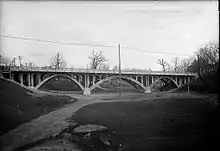Crawford Street Bridge
Crawford Street Bridge is one of two known bridges that once spanned over Garrison Creek valley (the actual creek disappeared as brick sewer in 1885 [1]) in Toronto, Ontario, Canada, and buried intact in the 20th century. The bridge shares design features with the larger Prince Edward Viaduct.
Crawford Street Bridge | |
|---|---|
 | |
| Coordinates | 43°38′57″N 79°24′54″W |
| Carries | single vehicle lanes for both directions |
| Crosses | Garrison Creek |
| Locale | Toronto, Ontario, Canada |
| Characteristics | |
| Design | triple span arch bridge |
| Total length | 52 metres (170 feet) - approx. |
| Clearance above | unlimited |
| History | |
| Opened | 1915 |
| Location | |

| |
The Crawford Bridge was a triple span Arch bridge built in 1914 to 1915 to replace an early wooden bridge (1884) that spanned Garrison Creek in the area known today's as Trinity-Bellwoods.[2] The bridge's design was influenced by Public Works Commissioner R.C. Harris with a more pleasing structure for the public. The bridge was built to allow residents in the new residential development along Crawford Street to cross over the valley over from north of Lobb Avenue to the south of Dundas Street West.
In the 1960s the valley on either side was filled in with earth dug from building the Bloor subway. It was the last of few bridges that spanned Garrison Creek to be removed, most before the 1940s. The actual bridge was not torn down, but rather buried with only the railings and lamp posts removed. The City of Toronto government performed maintenance work in 2004 that narrowed the roadbed and rebuilt sidewalks on both sides. Foaming grout was added to fill the voids of the bridge with hope for future restoration of the entire bridge.[3] Today there are no visible signs of the bridge being present other than plaques and sidewalk markers added in 2008 by the City of Toronto. Once rolling landscape, houses and flat Trinity Bellwoods Park now surround the bridge.
See also
Other bridges that used to span Garrison Creek:
- Harbord Street Bridge
- Shaw Street Bridge - a wood bridge over Sully Crescent and Garrison Creek was filled in by the 1920s[4]